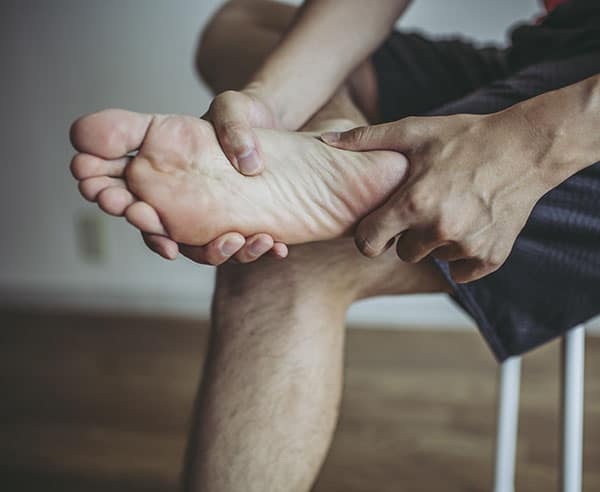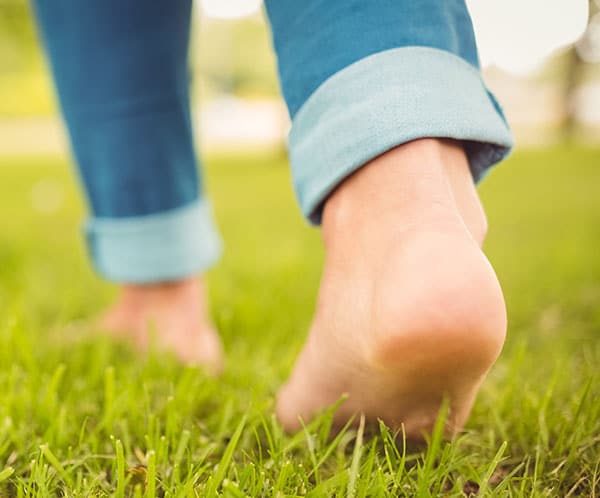Heel Pain Treatment
Are your heels constantly complaining?
If so, then you’re likely familiar with the routine many Americans go through every day – morning comes and the first thing to greet you is that pain. But no big deal, right? It usually goes away after a little while.
Well, Dr. Michael McCourt is here to tell you otherwise. Heel pain is a big deal, and you should not think of it as a normal part of life. In fact, hoping it will eventually go away won’t solve the problem. Instead, you are likely to make the condition much worse when you don’t seek the appropriate forms of treatment.
At Eugene Foot and Ankle, we treat people every day who either believed there was no hope of getting rid of their discomfort, or who assumed that their heel pain wasn’t a concern (until it was). We take great pride in knowing that we don’t just offer accurate diagnosis and effective treatments; we also restore hope and quality of life to those who may have forgotten how wonderful life can actually be without heel pain.
So What is Causing Your Heel Pain?
There are many possible foot and ankle conditions that could be causing pain in your heel(s). But, generally, the root cause for the development of these painful conditions is faulty biomechanics, or walking gait abnormalities. These flaws in walking patterns can place unnecessary stress on the heel bone and soft tissues that attach to it which, in turn, leads to conditions that cause heel pain.
However, this unnecessary stress may also result from injury or a bruise sustained while walking, running, or jumping on hard surfaces, as well as being overweight and wearing poorly constructed footwear (like flip-flops).
Some of the most common conditions that may develop from unstable biomechanics include:
- Heel Spurs. A bony growth on the underside of the heel bone. A spur, visible by X-ray, appears as a protrusion that can extend forward as much as half an inch. When there is no indication of bone enlargement, the condition is sometimes referred to as “heel spur syndrome.”
- Plantar Fasciitis. Both heel pain and heel spurs are frequently associated with plantar fasciitis, an inflammation of the band of fibrous connective tissue (fascia) running along the bottom of the foot, from the heel to the ball of the toes. The condition occurs when the plantar fascia is strained over time beyond its normal range, causing the soft tissue fibers of the fascia to tear or stretch at points along its length.
- Achilles Tendinitis. Pain at the back of the heel is associated with Achilles tendinitis, which is inflammation of the Achilles tendon as it runs behind the ankle and inserts on the back surface of the heel bone. The condition occurs when the tendon is strained over time, causing the fibers to tear or stretch along its length, or at its insertion on to the heel bone.
It is also worth mentioning other not-as-common conditions, however, like rheumatoid arthritis, bursitis, and bone bruises or contusions.
What all these conditions have in common is the fact that professional treatment is often required to effectively address the problem and successfully get rid of it.
Is It Time to Come Visit Our Office?
If you are experiencing heel pain, then that should be your first hint that it is, indeed, time to make an appointment with Dr. McCourt. But aside from general pain in your heel, there are also some other symptoms to keep in mind, like:
- Swelling around the heel
- Swelling on the bottom of the heel
- Tingling or burning sensation in the heel
- Pain that is usually worse upon rising
- Inability to stretch the foot
- Pain on the bottom of the heel
- Pain in the back of the heel
- Pain in the arch of the foot
- Pain that increases over time
Now, we’ve said it once and we will say it once more – heel pain is not normal and getting the help you need is vital for optimal recovery. If pain and other symptoms of inflammation persist, then you should limit normal daily activities and contact our office right away. We can help you put that pep back in your step.
And what’s better, when you address symptoms at its early stages, conservative treatment methods may be all you need to say goodbye to heel pain for good.
How Can We Help You?
Some common conservative treatment methods we may recommend include:
- I.C.E (rest, icing, compression and elevation of the area several times a day)
- Over-the-counter pain relievers, like ibuprofen
- Bracing or splinting the foot
- Wearing custom orthotics
- Wearing protective and supportive shoes
- Avoiding certain activities or high-impact exercises
Conservative treatment is usually the first course of action unless the condition is more serious. And only once we have exhausted all non-surgical care and pain is still present will we decide on more aggressive tactics for handling your symptoms.
We may also recommend steroid injections, physical therapy, or a combination of these treatments.
While traditional conservative treatments are effective in most cases, some especially stubborn or severe cases may require a more advanced approach.
Fortunately, we are a regional leader in providing state-of-the-art, regenerative, non-surgical treatment options such as platelet-rich plasma, and shockwave therapy for chronic heel pain that hasn’t responded well to other treatments.
If you’re interested in learning more about these care options and how they can help you, please read our webpage on advanced treatments for chronic pain.
Find Heel Pain Relief at Eugene Foot and Ankle
Don’t let your heels run your life! There are simple and easy solutions to manage your symptoms and promote faster healing. We are well equipped with the best tools and knowledge available to help you get back on your feet as quickly and as safely as possible.
Give Eugene Foot and Ankle a call at (541) 683-3351 today to schedule an appointment. You can also reach us electronically through our handy request form online.
Excessive Pronation: Heel pain sometimes results from excessive pronation. Pronation is the normal flexible motion and flattening of the arch of the foot that allows it to adapt to ground surfaces and absorb shock in the normal walking pattern.
As you walk, the heel contacts the ground first; the weight shifts first to the outside of the foot, then moves toward the big toe. The arch rises, the foot generally rolls upward and outward, becoming rigid and stable in order to lift the body and move it forward. Excessive pronation—excessive inward motion—can create an abnormal amount of stretching and pulling on the ligaments and tendons attaching to the bottom back of the heel bone. Excessive pronation may also contribute to injury to the hip, knee, and lower back.
Achilles Tendinitis: Pain at the back of the heel is associated with Achilles tendinitis, which is inflammation of the Achilles tendon as it runs behind the ankle and inserts on the back surface of the heel bone. It is common among people who run and walk a lot and have tight tendons.
The condition occurs when the tendon is strained over time, causing the fibers to tear or stretch along its length, or at its insertion on to the heel bone. This leads to inflammation, pain, and the possible growth of a bone spur on the back of the heel bone. The inflammation is aggravated by the chronic irritation that sometimes accompanies an active lifestyle and certain activities that strain an already tight tendon.
Other possible causes of heel pain include:
- Rheumatoid arthritis and other forms of arthritis, including gout, which usually manifests itself in the big toe joint.
- An inflamed bursa (bursitis), a small, irritated sac of fluid; a neuroma (a nerve growth); or other soft-tissue growth. Such heel pain may be associated with a heel spur or may mimic the pain of a heel spur.
- Haglund’s deformity (“pump bump”), a bone enlargement at the back of the heel bone in the area where the Achilles tendon attaches to the bone. This sometimes-painful deformity generally is the result of bursitis caused by pressure against the shoe and can be aggravated by the height or stitching of a heel counter of a particular shoe;
- A bone bruise or contusion, which is an inflammation of the tissues that cover the heel bone. A bone bruise is a sharply painful injury caused by the direct impact of a hard object or surface on the foot.
When to Visit a Podiatrist
If pain and other symptoms of inflammation—redness, swelling, heat—persist, limit normal daily activities and contact a doctor of podiatric medicine.
Diagnosis and Treatment
The podiatric physician will examine the area and may perform diagnostic X-rays to rule out problems of the bone.
Early treatment might involve oral or injectable anti-inflammatory medication, exercise and shoe recommendations, taping or strapping, or use of shoe inserts or orthotic devices. Taping or strapping supports the foot, placing stressed muscles and tendons in a physiologically restful state. Physical therapy may be used in conjunction with such treatments.
A functional orthotic device may be prescribed for correcting biomechanical imbalance, controlling excessive pronation, and supporting the ligaments and tendons attaching to the heel bone. It will effectively treat the majority of heel and arch pain without the need for surgery.
Only a relatively few cases of heel pain require more advanced treatments or surgery. If surgery is necessary, it may involve the release of the plantar fascia, removal of a spur, removal of a bursa, or removal of a neuroma or other soft-tissue growth.
Prevention
A variety of steps can be taken to avoid heel pain and accompanying afflictions:
- Wear shoes that fit well—front, back, and sides—and have shock-absorbent soles, rigid shanks, and supportive heel counters
- Wear the proper shoes for each activity
- Do not wear shoes with excessive wear on heels or soles
- Prepare properly before exercising. Warm up and do stretching exercises before and after running.
- Pace yourself when you participate in athletic activities
- Don’t underestimate your body’s need for rest and good nutrition
Contact Us
Eugene
Hours:
Monday............ 8:00am - 5:00pm
Tuesday............ 8:00am - 5:00pm
Wednesday............ 8:00am - 5:00pm
Thursday............ 8:00am - 5:00pm
Friday............ 8:00am - 4:00pm (Only available on phones)
Closed for lunch from 12pm - 1pm and closed until 1:30pm on Tuesdays
© Copyright 2025 Eugene Foot and Ankle. All Rights Reserved. | Privacy Policy.


